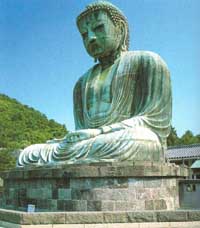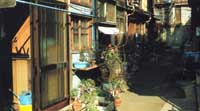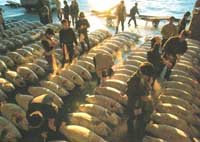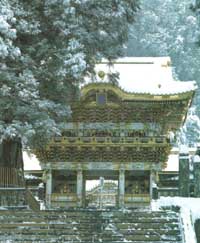by Chalerm Raksanti
 This
37 foot Daibutsu (Great Buddha) was cast in 1252.
This
37 foot Daibutsu (Great Buddha) was cast in 1252.
Anyone wishing to understand Japan must sooner or later
come to grips with the astounding megalopolis that is modern Tokyo.
Although Japan has 10 other cities with populations over 1 million, Tokyo
is unparallel in terms of wealth, population, modernity, economic
importance and international feeling. It is, after all, a city that
stretches over 2,000 square miles, is home to more than 18 million people,
and has an annual budget larger than that of China. One can also say that
Tokyo best represents modern Japan, for it is the showcase of what the
Japanese, for good or bad, are making their nation.
 One
of Tokyo’s rare old fashion residential neighborhoods.
One
of Tokyo’s rare old fashion residential neighborhoods.
Tokyo is not an ancient city. Although the Kanto Plain
on which it is located was inhabited in prehistoric times, the city’s
rise to prominence began when Tokugawa Ieyasu established his headquarters
there in 1603. Ieyasu, having been granted a domain covering most of the
Kanto Plain, built his castle on land that is now part of the Imperial
Palace grounds. The remains of the circular moats can still be discerned
today.
 Seafood
for Tokyo’s millions of fish lovers passes through the wholesale market
at Tsukji.
Seafood
for Tokyo’s millions of fish lovers passes through the wholesale market
at Tsukji.
Through two centuries the city prospered, and the
pursuit of pleasure led to the rise of a new middle-class urban culture.
This culture is reflected in theater arts that thrive today like Kabuki
and Noh as well as in institutions that no longer exist, such as the great
pleasure quarters of Yoshiwara. The daily lives of the courtesans,
samurai, actors and artists of old Edo are preserved in the colorful
woodblock prints called ukiyo-e. The word is derived from a Buddhist term
for the underlying insubstantiality of the real world and reflects the
appreciation of the ephemeral beauty of life, an esthetic value since the
Heian period.
 Seventy
five miles north of Tokyo lies Nikko, where the tomb of the first shogun,
Tokugawa Iyeasu is located on the grounds of this lavish mausoleum.
Seventy
five miles north of Tokyo lies Nikko, where the tomb of the first shogun,
Tokugawa Iyeasu is located on the grounds of this lavish mausoleum.
It was a hard life in those days, one emphasized by
natural or man-made disasters. Most frequent and most damaging were the
fires known as “flowers of Edo”. These were usually started by cooking
fires that spread due to one of the frequent earthquakes or by simple
carelessness. Fires, earthquakes, typhoons, floods made life precarious.
Two events in the mid-19th century ensured that Edo would maintain its
economic, cultural and political sway over the nation. The first was the
opening of Japan to the West by Commodore Perry, ending two centuries of
self-imposed seclusion. The second was the overthrow of Tokugawa
leadership by a group of young samurais from western Japan.
Tokyo’s rapid growth suffered a severe blow with the
Tokyo earthquake of 1923. During the disaster, in which fires did more
damage that the quake itself, over 100,000 people died and 60 percent of
the homes were destroyed.
Modern Tokyo enjoys an excellent transportation system,
a low crime rate, and a budget surplus. Of course it is not a city without
problems, chiefly the high cost of land. Japan’s capital of today is
definitely not a place of grand vistas, but of discrete and interesting
places, colorful and noisy shopping streets near train stations, not to
mention nightlife offerings of a variety and quantity unmatched in the
world. Tokyo is not a beautiful city, but a pleasant one. Not a historical
city, but for the Japanese, a very livable one.

 This
37 foot Daibutsu (Great Buddha) was cast in 1252.
This
37 foot Daibutsu (Great Buddha) was cast in 1252. One
of Tokyo’s rare old fashion residential neighborhoods.
One
of Tokyo’s rare old fashion residential neighborhoods. Seafood
for Tokyo’s millions of fish lovers passes through the wholesale market
at Tsukji.
Seafood
for Tokyo’s millions of fish lovers passes through the wholesale market
at Tsukji. Seventy
five miles north of Tokyo lies Nikko, where the tomb of the first shogun,
Tokugawa Iyeasu is located on the grounds of this lavish mausoleum.
Seventy
five miles north of Tokyo lies Nikko, where the tomb of the first shogun,
Tokugawa Iyeasu is located on the grounds of this lavish mausoleum.
